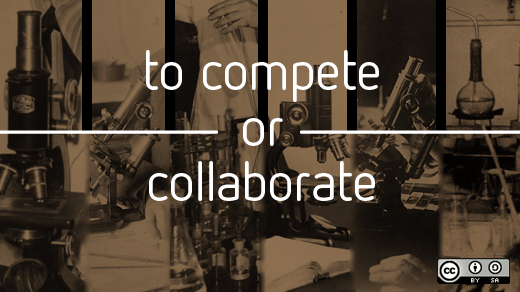Open organizations function best as meritocracies—places where, as people in open source communities tend to say, "code talks."
By that, they usually mean that what you do is more important than what you say you can do or will do. In meritocracies, reputation matters more than title. What you've proven you can do (and what others recognize you can do) are the truest markers of influence and authority in open organizations. As a result, great ideas really can come from anywhere in these organizations, not just from the top of the organizational chart.
But ideas don't just arise out of thin air. They're the product of passionate people doing what they love—together. So the idea that good ideas can come from anywhere has a corollary: In open organizations, good leaders can come from anywhere, too.
And as someone working in an open organization for the past five years, I've come to learn that success depends on helping these leaders emerge, thrive, and innovate on terms they help establish—not terms I dictate.
Ends and means
In organizations with strong, deeply embedded hierarchies, those hierarchies tend to function as both the ends and the means.
What do I mean by that? When you are working in a hierarchy, what do you consider success? Moving up in that hierarchy! And what is the best way to do that? Become an expert at navigating the hierarchy!
When I was working as a consultant for more traditional organizations, for example, I saw many people with a singular goal: getting promoted. They directed all their energies toward this goal. They carefully charted their paths up the hierarchy. They became masters of it, knowing how to leverage it strategically. They focused on pleasing and appeasing leaders above them. And if this wasn’t your plan, then your peers tended to wonder what you were really all about.
But behaving this way has a huge downside.
When you focus exclusively on moving up a hierarchy, you tend to cling closely to the parts of the organizational chart that you know best, the people and functions you are most comfortable with, because you know the ascent is far more likely and quicker. In effect, you silo yourself!
Your obsession with moving up a hierarchy can take your eyes off other crucial goals: like furthering your company's mission, generating value for your customers, coming up with innovative ideas, and learning new skills. Ends and means: The goal is to climb the hierarchy, and the most effective route to do that is to use the hierarchy. And so the hierarchy gets more deeply entrenched, as do the people who inhabit it. This is one of the fundamental reasons why most companies have an extremely difficult time shifting away from hierarchies as the source of power.
Achievement, not advancement
When I arrived at Red Hat, I noticed something that gave me pause: Hundreds of people who just seemed disinterested in moving up the organizational chart.
I don't mean to suggest that these people were apathetic, unengaged, or dispassionate. Far from it! At Red Hat, I have met some of the most enthusiastic and committed people I've ever known. But they're committed to something else: Building better technology the open source way, not advancing in a hierarchy.
As a result, they tend not to think in terms of lines and boxes. (In fact, at Red Hat, although we have organizational structures, finding an actual organization chart can be very difficult!) Red Hatters move across boundaries and form cross-functional teams to develop richer, more effective solutions. They're not competing for promotions. They're collaborating to make commotions—to stir things up, to rethink things, to foster working relationships that cut across departments and teams. They're working hard to do what they love by linking their passions and talents to Red Hat's mission. They understand hierarchies not as something to be climbed, but as something to be traversed.
The more they succeed at this, the more engaged they become. The more engaged they become, the more they earn the respect of those around them. New ends (achieving the company's mission), and new means (maximizing their abilities and making themselves the best at what they do).
At Red Hat, we're focused on achievement, not advancement. This is an important distinction Jim Whitehurst makes in The Open Organization. "In conventional organizations," he says, "it's all about advancement—how far you can climb the corporate ladder in order to gain the kind of power and influence you crave." It's important to understand that managers and other leaders who blindly reward their best-performing associates with promotions might actually be doing those people a disservice! To drive this home, Jim paints a familiar scenario:
If you are a top software developer, for example, the only way you can get promotions, raises, and increase your influence in a conventional organization is to get promoted into a management role, even if you happen to hate the idea of managing other people and regardless of whether you are even good at it.
By making advancement a kind of "default" reward, you run the risk of alienating your most passionate people. This is especially true in open organizations, where people think of themselves not in terms of the titles they hold, but in terms of the contributions they make. Keep them from making the contributions that matter most to them, and you're in danger of diminishing their engagement.
Avoiding this means thinking differently about success. Rather than reward contributions with promotions, what else can you do to show your appreciation for the people in your organization who are making a difference? Here are a few options to consider:
- Ask them to lead a critical project
- Make a point of consulting them when you’re weighing a big decision
- Allow them to “swap” jobs with someone in another country for a few months
- Send them to classes, workshops, or conferences to help them explore topics they care about
- Ensure they are paid more than fairly (you don’t need to change titles or become a people manager in order to receive a raise!)
- Renegotiate their responsibilities and free them to spend time on the projects they are passionate about
- Establish a peer award program so associates can recognize one another’s leadership abilities
Leaders everywhere
At Red Hat, I'm constantly surrounded by leaders—on multiple teams, in multiple departments, and on multiple continents! They're leaders not necessarily because they've climbed a hierarchy to acquire an impressive-sounding title. They're leaders because they've proven that they do what they love so well that others find them inspiring.
They've found a purpose at work, and that purpose has nothing to do with climbing a corporate ladder. It has everything to do with making the kinds of contributions that make them feel valuable.






4 Comments